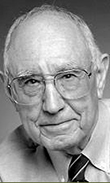Stark Galleries war exhibit honors storied alum Peña, fellow Aggies

William Peña
A multimedia exhibit honoring five World War II Aggie heroes, including William Merriweather Peña ‘42, an [Outstanding Alumnus] (https://www.arch.tamu.edu/community/formerstudents/outstanding-alumni/past-honorees/60/) of the Texas A&M College of Architecture, runs through Dec. 16, 2017 at the Memorial Student Center’s [J. Wayne Stark Galleries] (https://www.google.com/maps/place/J+Wayne+Stark+University+Center+Gallery/@30.612428,-96.3434367,17z/data=!3m1!4b1!4m5!3m4!1s0x86468ff1d02902af:0xe2ed890cb12303ff!8m2!3d30.612428!4d-96.341248) .
The exhibit, “ [Texas Aggies Go To War] (http://aggiesgotowar.org/) ,” tells the tales of Peña, James Hollingsworth ‘40, Turney Leonard ‘42, Joe Routt ‘37 and James Earl Rudder ’32, who helped repel Germany’s final major World War II offensive in the Battle of the Bulge.
These five heroes were among the more than 610,000 American forces that fought in the December 16, 1944 to January 25, 1945 campaign, in which approximately 89,000 were injured or killed.
Peña, who recounted his service in a memoir, “ [As Far As Schleiden] (http://crs.arch.tamu.edu/activites/publications/AS%20FAR%20AS%20SCHLEIDEN.pdf) ,”was deployed to Europe in September 1944 after reporting to officer training school just hours after he graduated from Texas A&M. He led a heavy weapons platoon through the dense, snow covered forests of Germany and Belgium during the battle. After the pivotal engagement, Peña lost a leg from a mine explosion while repairing an Allied communications line in Germany.
The exhibit also features Rudder, the future Texas A&M president, who led a group of U.S. Army Rangers that performed one of the war’s greatest feats, scaling the 90-foot cliffs at Normandy’s Pointe du Hoc under heavy enemy fire to help secure an Allied victory on D-Day.
Hollingsworth was a tank commander under Gen. George Patton, Leonard lost an arm in a shell explosion and later died on the battlefield, and Routt was killed while leading an infantry company. Peña is the only living exhibit honoree.
The exhibit, which [debuted] (http://one.arch.tamu.edu/news/2015/1/12/belgian-war-museum/) in a Belgian museum in 2014 for the 70th anniversary of the Battle of the Bulge, is sponsored by the [Texas A&M University System] (http://www.tamus.edu/) and municipal and corporate sponsors in the United States and Belgium. It expresses Belgians’ gratitude for the U.S. role in the war, which launched an era of diplomatic and economic cooperation between the two nations.
In December 2016, Peña was presented with Belgium’s second-highest order of chivalry, the Commander in the Order of the Crown, by Princess Astrid of Belgium and a host of international dignitaries during a ceremony at Texas A&M’s Rudder Theatre.
After the war, Peña began what would become a legendary career in architecture by joining [Caudill Rowlett Scott Architects] (http://crs.arch.tamu.edu/about-us/history/) in 1948. He became known as the “father” of architectural programming and in 1969 co-authored the first edition of “ [Problem Seeking] (http://www.amazon.com/Problem-Seeking-Architectural-Programming-Primer/dp/0471126209) ,” which remains a standard textbook in architectural education.
He is a Distinguished Alumnus of Texas A&M and a member of the prestigious American Institute of Architects’ [College of Fellows] (https://network.aia.org/cof/home) .
In 2013, he received France’s highest honor, the medal of Chevalier of the [National Order of the Legion of Honour] (http://www.britannica.com/EBchecked/topic/335043/Legion-of-Honour/) , during a 2013 Veterans Day ceremony at Minute Maid Park in Houston for his role in liberating France in World War II.
Richard Nira
rnira@arch.tamu.edu
Tags
Related Posts
Belgian museum exhibit honors Peña, fellow Aggie soldiers

Former student’s MSC installation debuts in late 2012
Architect, war hero William Peña named distinguished alum

Former student’s ‘birdhouse’ design garners honors

Alums honor Greer, create professorship
Follow Us
Facebook Twitter Vimeo Youtube Flickr RSS
Recent Posts

Planning prof heads study of disaster housing aid

A message from the dean

Former student remembered as expert planner

Leading educator named new head of Architecture Dept.







_thumbnail_small.png)
